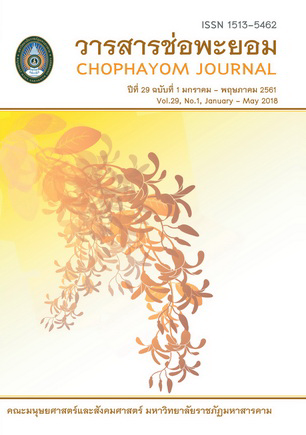แผนยุทธศาสตร์การค้ามันสําปะหลังเส้นของไทยไปยังสาธารณรัฐประชาชนจีนแผนยุทธศาสตร์การค้ามันสำปะหลังเส้นของไทยไปยังสาธารณรัฐประชาชนจีน The Thai Tapioca Chip Trading Strategic Plan to China
Abstract
บทคัดย่อ
การวิจัยครั้งนี้ มีวัตถุประสงค์เพื่อ1) ศึกษาปัจจัยที่ส่งผลต่อปริมาณการส่งออกมันสำปะหลังเส้นของไทยไปยังสาธารณรัฐประชาชนจีน2)วิเคราะห์สภาพแวดล้อมของอุตสาหกรรมมันสำปะหลังเส้นของไทย3)สร้างแผนยุทธศาสตร์การค้ามันสำปะหลังเส้นของไทยไปยังสาธารณรัฐประชาชนจีนวิธีการดำเนินการวิจัยแบ่งเป็น 3 ระยะ คือระยะที่ 1 เพื่อศึกษาปัจจัยที่ส่งผลต่อปริมาณการส่งออกมันสำปะหลังเส้นของไทยไปยังสาธารณรัฐประชาชนจีนและสภาพแวดล้อมของอุตสาหกรรมมันสำปะหลังเส้นไทย ระยะที่ 2เพื่อสร้างแผนยุทธศาสตร์การค้ามันสำปะหลังเส้นของไทยไปยังสาธารณรัฐประชาชนจีนและระยะที่ 3 เพื่อประเมินและยืนยันแผนยุทธศาสตร์การค้ามันสำปะหลังเส้นของไทยไปยังสาธารณรัฐประชาชนจีนที่สังเคราะห์ขึ้นจากการศึกษา ผลการวิจัยพบว่า
1. ปัจจัยที่มีผลกระทบต่อปริมาณยอดขายมันสำปะหลังเส้น ได้แก่ ปัจจัยด้านราคาขาย ปัจจัยด้านความนิยมในตัวสินค้า ปัจจัยด้านจำนวนยอดการสั่งซื้อสินค้าของลูกค้า ปัจจัยด้านการเติบโตของกิจการของลูกค้าและปัจจัยด้านราคาสินค้าที่ใช้ทดแทนกัน
2. สภาพแวดล้อมของอุตสาหกรรมมันสำปะหลังเส้นไทยที่สำคัญในแต่ละด้านคือ ด้านจุดแข็งพบว่า ประเทศไทยมีผลผลิตมากเพียงพอต่อความต้องการใช้ภายในประเทศและส่งออกไปยังต่างประเทศ ด้านจุดอ่อนพบว่า คุณภาพมันสำปะหลังเส้นไทยในภาพรวมค่อนข้างตํ่า รวมถึงต้นทุนด้านต่างๆ ที่เกี่ยวข้องค่อนข้างสูง ด้านโอกาสพบว่า ประเทศจีนมีโอกาสนำ เข้ามันสำปะหลังเส้นมากขึ้นเนื่องจากอุตสาหกรรมต่อเนื่องที่ต้องใช้ใช้ผลิตภัณฑ์มันสำปะหลังเป็นวัตถุดิบของจีนมีการขยายตัวและเติบโตต่อเนื่อง ด้านอุปสรรคพบว่าตลาดมันสำปะหลังเส้นของไทยมีเพียงประเทศจีนตลาดเดียวทำให้ผู้ประกอบการไทยขาดอำนาจต่อรองและมีโอกาสที่ผู้นำเข้าจะเข้ามาเปิดจุดรับซื้อและส่งออกด้วยตนเอง 3. แผนยุทธศาสตร์การค้ามันสำปะหลังเส้นของไทยไปยังสาธารณรัฐประชาชนจีน มี 4 ยุทธศาสตร์ 17 มาตรการ ประกอบด้วย 1) ยุทธศาสตร์ผลักดันให้ไทยเป็นศูนย์กลางการค้ามันสำปะหลังเส้นของอาเซียน 4 มาตรการ 2) ยุทธศาสตร์ทบทวนและปรับปรุงนโยบายต่างๆ ที่เกี่ยวข้อง 6 มาตรการ 3) ยุทธศาสตร์สร้างเสถียรภาพและเพิ่มความได้เปรียบของมันสำปะหลังเส้นไทย 5 มาตรการ และ 4) ยุทธศาสตร์ลดการพึ่งพาจีน 2 มาตรการ คำสำคัญ : แผนยุทธศาสตร์, การค้ามันสำปะหลังเส้น
ABSTRACT
The objectives of this research are to: 1) examine factors affecting the export quantity of Thai tapioca chips to China, 2) analyze the environments of Thai tapioca industry, and 3) createThai tapioca chip trading strategic plan to China. The research process is divided into three phases.The first one is to examine factors determining the export quantity of tapioca chips to China, and to study the environments of Thai tapioca industry.The next phase is to create Thai tapioca chip trading strategic plan to China.Finally, the last phase is to evaluate the possibility and reaffirm Thai tapioca chip trading strategic planto China created in the second phase. The research results areas follows: 1. The factors affecting the sales volume of tapioca chips arethe price of tapioca chips, the product preferences, the number of customers’ purchasing orders, the growth of customers’ companies, and the price of substitute products. 2. The important environmentsof Thai tapioca chip industry show that in terms of the strength, Thailand has capacity to produce tapioca chips sufficiently for domestic use and export. However, the weakness is the low quality of Thai tapioca chips, including the higher relevant cost. In terms of opportunity, the research found that China tends to import more tapioca chips due to the continuous growth of the Chinese industries which use them as raw materials. Nevertheless,
the threat for Thai tapioca chip industry is that they rely only on the Chinese market, resulting in the lack of bargaining powerThere is also the possibility that Chinese importers will come to buy and export by themselves. 3. The Thai tapioca chip trading strategic plans to China consist of four strategies and 17 measures which are; 1) four measures to push forward Thailand to be a tapioca trading center of ASEAN, 2) six measures to review and improve relevant policies, 3) five measures to stabilize and increase the advantage of Thai tapioca chips, and 4) two measures to reduce dependence on Chinese market. Keywords : Strategic Plan, Tapioca Chip Trading






